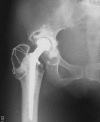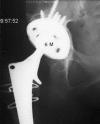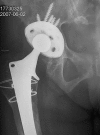Clinical and radiographic assessment of cementless acetabular revision with morsellised allografts
- PMID: 19242693
- PMCID: PMC2899160
- DOI: 10.1007/s00264-009-0722-4
Clinical and radiographic assessment of cementless acetabular revision with morsellised allografts
Abstract
The aim of this study was to evaluate the clinical and radiographic results of cementless acetabular revision with deep frozen morsellised allografts. Sixty-one patients (65 hips) underwent acetabular revision using cementless components and deep frozen morsellised allografts. Fifty-seven hips (53 patients) were reviewed at a mean of 105.1 months (range 72-180 months) after revision. The study group included 29 males and 24 females with a mean age of 46.4 years. One cup underwent further revision for aseptic loosening and two were defined as radiographic failures. The mean time for allograft incorporation was 12.5 months (range 6-24 months) after index surgery. The mean Harris hip score of the patients improved from 61.1 points preoperatively to 91.6 points postoperatively. Linear and cavitary osteolysis was observed in two and 12 hips, respectively. The acetabular revision using cementless components with deep frozen morsellized allografts provides favourable clinical and radiographic results, although the initial disease and age may adversely affect the outcomes.
L’objectif de cette étude est d’évaluer les résultats cliniques et radiographiques de la chirurgie de révision acétabulaire associant allogreffes morcelées, cryoconservées. Matériel et méthode : 61 patients (65 hanches) ont bénéficié d’une reprise avec cupule sans ciment et allogreffes morcelées cryoconservées. 57 hanches (53 patients) ont été revues en moyenne à 105,1 mois (de 72 à 180 mois) après la révision. Ce groupe comprend 29 hommes et 24 femmes avec un âge moyen de 46,4 ans. Résultats : une cupule a nécessité une nouvelle reprise pour un descellement aseptique et 2 ont été cataloguées comme échec sur le plan radiographique. Le temps moyen de l’incorporation de l’allogreffe a été de 12,5 mois (entre 6 et 24 mois), le score moyen de Harris de ces patients s’est amélioré de 61,1 points en préopératoire à 91,6 points en postopératoire. Des ostéolyses linéaires et cavitaires ont été observées respectivement sur 2 et 12 hanches. Conclusions : la technique de révision acétabulaire utilisant un composant non cimenté avec des greffes morcellées cryoconservées permet d’obtenir des résultats cliniques et radiographiques fiables néanmoins, la pathologie initiale et l’âge des patients peuvent avoir des effets négatifs sur l’évolution.
Figures



Similar articles
-
[Acetabular revision for aseptic loosening in total hip arthroplasty using cementless cup and impacted morselized allograft].Rev Chir Orthop Reparatrice Appar Mot. 2007 May;93(3):255-63. doi: 10.1016/s0035-1040(07)90247-0. Rev Chir Orthop Reparatrice Appar Mot. 2007. PMID: 17534208 French.
-
Revision Total Hip Arthroplasty Using a Cementless Cup Supporter and Iliac Autograft: A Minimum of 15-Year Follow-Up.J Arthroplasty. 2017 Nov;32(11):3495-3501. doi: 10.1016/j.arth.2017.06.026. Epub 2017 Jun 20. J Arthroplasty. 2017. PMID: 28697865
-
[Acetabular revision by using uncemented cup and impacted morselized allografts].Zhongguo Xiu Fu Chong Jian Wai Ke Za Zhi. 2009 Sep;23(9):1062-6. Zhongguo Xiu Fu Chong Jian Wai Ke Za Zhi. 2009. PMID: 19817289 Chinese.
-
Bone defect determines acetabular revision surgery.Hip Int. 2014 Oct 2;24 Suppl 10:S33-6. doi: 10.5301/hipint.5000162. Hip Int. 2014. PMID: 24970036 Review.
-
Long-term results of acetabular reconstruction using irradiated allograft bone.Bone Joint J. 2018 Nov;100-B(11):1449-1454. doi: 10.1302/0301-620X.100B11.BJJ-2018-0478.R2. Bone Joint J. 2018. PMID: 30418060 Review.
Cited by
-
Acetabular Cup Revision Arthroplasty Using Morselized Impaction Allograft.Hip Pelvis. 2018 Jun;30(2):65-77. doi: 10.5371/hp.2018.30.2.65. Epub 2018 Jun 4. Hip Pelvis. 2018. PMID: 29896455 Free PMC article. Review.
-
The use of morselized allografts without impaction and cemented cage support in acetabular revision surgery: a 4- to 9-year follow-up.J Orthop Surg Res. 2015 May 23;10:77. doi: 10.1186/s13018-015-0222-8. J Orthop Surg Res. 2015. PMID: 25998544 Free PMC article.
-
Is Retention of the Acetabular Component at Revision Surgery a Long-Term Solution?Arthroplast Today. 2023 Aug 26;23:101197. doi: 10.1016/j.artd.2023.101197. eCollection 2023 Oct. Arthroplast Today. 2023. PMID: 37662496 Free PMC article.
-
Biphasic bone graft substitute in revision total hip arthroplasty with significant acetabular bone defects : a retrospective analysis.Bone Jt Open. 2022 Dec;3(12):991-997. doi: 10.1302/2633-1462.312.BJO-2022-0094.R1. Bone Jt Open. 2022. PMID: 36545948 Free PMC article.
-
The use of fibre-based demineralised bone matrix in major acetabular reconstruction: surgical technique and preliminary results.Int Orthop. 2011 Feb;35(2):283-8. doi: 10.1007/s00264-010-1145-y. Epub 2010 Nov 6. Int Orthop. 2011. PMID: 21057788 Free PMC article.
References
-
- Callaghan JJ, Salvati EA, Pellicci PM, et al. Results of revision of mechanical failure after cemented total hip replacement, 1979 to 1982: a two to five year followup. J Bone Joint Surg AM. 1985;67:1074–1085. - PubMed
-
- Marti RK, Schuller HM, Besselaar PP, et al. Results of revision of hip arthroplasty with cement: a five to fourteen-year followup study. J Bone Joint Surg AM. 1990;72:346–354. - PubMed
-
- Hungerford DS, Jones LC. The rationale of cementless revision of cemented arthroplasty failures. Clin Orthop Relat Res. 1988;235:12–24. - PubMed
-
- Lie SA, Havelin LI, Furnes ON, et al. Failure rates for 4762 revision total hip arthroplasties in the Norwegian Arthroplasty Register. J Bone Joint Surg Br. 2004;86:504–509. - PubMed
MeSH terms
LinkOut - more resources
Full Text Sources
Medical

